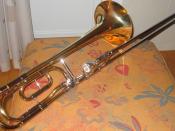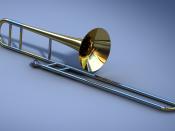The Trombone
The trombone is certainly the most recognizable wind instrument, being the only one with a true slide section. The trombone has been in existence for centuries under various forms and names, but has remained relatively unchanged for a majority of that time.
In the 15th century, when trombones developed from the Renaissance slide trumpet, they were called trombone in Italian and Posaune in German, just as they are today. In English, however, they were known as sackbuts.
The slide trumpet was unique because its mouthpiece could telescope into the adjacent lead pipe, thereby shortening the instrument and changing the pitch. The sackbut kept the sliding idea, but separated the sliding area from the bell; that way the bell always remained the same distance from the mouth of the player.
The oldest sackbut still in existence today was built in 1551. The bell of the Renaissance instrument was smaller than today's trombone, its walls were thinner and it had no water key.
Most sackbuts were in B flat (actually a very sharp A), similar to today's tenor trombone. By 1650, the right hand grip (the vertical tube that connects the two horizontal tubes of the slide) was added, allowing the right hand to execute the sliding motion more easily. Four sizes of sackbuts gave the musician considerable range; alto, tenor, bass and double bass were all used.
By the mid 1550's, composers realized that sackbuts blended well with the voice; more and more church music was written for choir and accompanied by sackbuts and cornets (not the cornet related to the valve trumpet). For over 100 years, the sackbut was considered an ecclesiastical instrument. Andrea and Giovanni Gabrieli wrote many pieces specifically for St. Mark's in Venice, which had two choir lofts facing each other. Sackbuts and cornets played...


